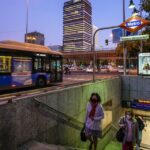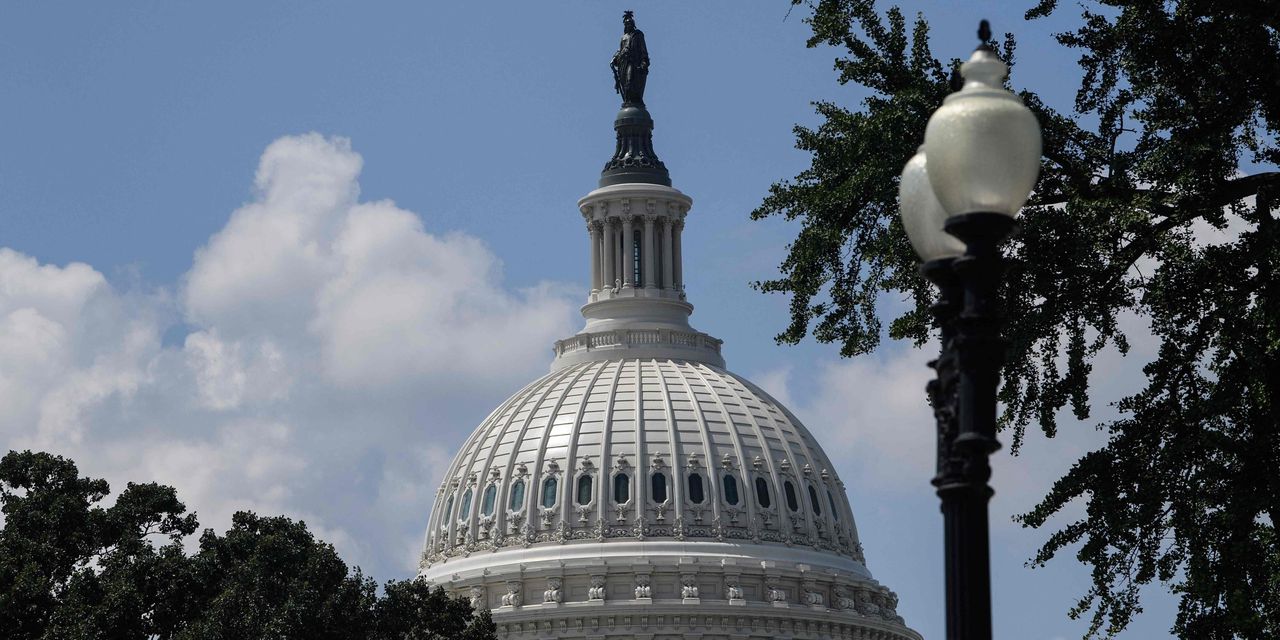STANYTSIA LUHANSKA, Ukraine—The Russian-controlled areas of Ukraine’s Luhansk and Donetsk regions were once the engines of the country’s economy and dominated its politics.
They produced its richest man, billionaire industrialist Rinat Akhmetov, as well as former President Viktor Yanukovych, ousted by the street protests that triggered the Russian invasion in 2014.
Since then, however, the two areas—now nominally independent “people’s republics” inside the larger regions of Luhansk and Donetsk—have turned into impoverished, depopulated enclaves that increasingly rely on Russian subsidies to survive. As much as half the prewar population of 3.8 million has left, for the rest of Ukraine, more prosperous Russia or Europe. Those who remain are disproportionately retirees, members of the security services and people simply too poor to move. Current economic output has shrunk to roughly 30% of the level before the Russian invasion, economists estimate.
As Russian President Vladimir Putin is massing more than 100,000 troops for a possible broader invasion of Ukraine, the developments in Donetsk and Luhansk show what many fear could happen to the rest of the country if he were to carry that out. The dismal record of Russian rule is one reason so many Ukrainian citizens, including Russian-speakers, are ready to take up arms so that their hometowns won’t meet the same fate.

Russia-controlled territory
Severodonetsk
Stanytsia Luhanska
DNIPROPETROVSK
Area of detail
ZAPORIZHIA
Sea of Azov

Russia-controlled territory
Stanytsia Luhanska
Severodonetsk
DNIPROPETROVSK
Area of detail
Sea of
Azov

Russia-controlled territory
Stanytsia Luhanska
Severodonetsk
DNIPROPETROVSK
Area of detail
Sea of
Azov
“The nightmare that started in 2014 in Donetsk has transformed the popular attitudes in mostly Russian-speaking parts of Ukraine,” said Oleksiy Goncharenko, a lawmaker from Odessa, one of the cities in southern and eastern Ukraine rocked by large-scale pro-Russian protests at the time.
“Back in 2014, the majority here were undecided—their main priority was to keep living normally, working in their businesses, sending their kids to school,” Mr. Goncharenko said. “Since then, they’ve seen very clearly that life is quiet only in the areas where the Ukrainian flag remains. They said: We don’t want to live in such a zombie zone, in some kind of Somalia.”
Borys Korolyov, a native of Luhansk city, is now studying at a university in the northeastern Ukrainian city of Kharkiv, some 220 miles away. On a recent day, he lingered for a few minutes while his cellphone still worked in Stanytsia Luhanska, a crossing point from Ukrainian-controlled to Russian-held areas. Then he picked up his suitcase and headed across a bridge into Luhansk, to visit his parents.
“In Kharkiv, there are new, unexpected things, opportunities at every corner,” said Mr. Korolyov. “In Luhansk, there is nothing to do except stay at home. Boring. No prospects for the future.”

A market stall near the Stanytsia Luhanska crossing point.

Buildings of a psychiatric hospital in the Slovyansk area last week that were damaged in the fighting in 2014. The area is in the Ukrainian-controlled part of the Donetsk region.
The Donetsk and Luhansk people’s republics are among a number of breakaway statelets Russia has fostered on its periphery as it seeks to undermine pro-Western neighbors. Russian troops also occupy the self-proclaimed republics of Abkhazia and South Ossetia in Georgia, and the Transnistria republic in Moldova. These territorial conflicts hamper the moves by Ukraine, Georgia and Moldova toward possible membership in the European Union and the North Atlantic Treaty Organization.
When unrest began in eastern Ukraine following Mr. Yanukovych’s ouster and the Russian takeover of Crimea in February 2014, it was led by local pro-Russian militants with the tacit support of local law enforcement and some oligarchs. In April 2014, heavily armed Russian military veterans led by former Russian intelligence officer Igor Girkin seized the city of Slovyansk in the Donetsk region, heralding the start of more open Russian military involvement.
Hastily formed Ukrainian volunteer battalions and the country’s then-dilapidated military responded with a bloody counteroffensive, retaking Slovyansk and a string of other rebel-held towns in the Donetsk and Luhansk regions, an area collectively known as Donbas.
When Ukrainian forces reached the outskirts of Donetsk and Luhansk cities in August 2014, Russia amped up its involvement, sending tanks, anti-aircraft batteries and long-range artillery across the border and imposing a cease-fire agreement on Kyiv.
Front lines have remained largely static since the latest Russian tank offensive in February 2015, even though sniper fire and artillery exchanges continue almost daily, with casualties on both sides.
Serhiy Shakun, known in Luhansk for his openly pro-Ukrainian opinions, operated one of the city’s largest taxi companies, with a fleet of 200 vehicles before the Russian takeover. In 2014, pro-Russian gunmen came to his office looking to detain him. Warned by a phone call, he took his family and escaped, eventually settling in Severodonetsk, the government seat of the Kyiv-held part of the Luhansk region. “They have taken everything. Nothing is left,” he said.

Serhiy Shakun in Severodonetsk.
Many other businesses and institutions were similarly expropriated. Isolyatsiya used to be a popular contemporary art space in Donetsk, hosting exhibitions and performances at a Soviet-era insulation materials factory. When Russian-backed militants took it over in 2014, saying the space was needed to store Russian humanitarian aid, they allowed staff to rescue a collection of Soviet-period social-realist paintings but smashed the contemporary art pieces, melting some of the statues and installations for scrap metal.
The Russian-installed official in charge of the facility, Leonid Baranov, went on television at the time to say that degenerate art had to be destroyed because it ran counter to the values of the new state, prevented young families from procreating and promoted hatred of the Russian idea.
Weeks later, Isolyatsiya’s compound turned into a detention facility operated by the Donetsk republic’s ministry of state security. One of the hundreds of prisoners there was Ukrainian novelist and journalist Stanislav Aseev, who was detained in 2017 after local security officials discovered he was contributing under a pen name to Ukrainian news outlets. Mr. Aseev, who says he was repeatedly tortured with electric shock, was freed in December 2019 as part of a prisoner exchange and now lives near Kyiv.
“They’ve managed to rebuild a Soviet system in the occupied territories—and not the Soviet system of the 1960s and 1970s, but a Soviet system of the 1930s and 1940s, with dungeons, with torture chambers, a system where lives are ruined if you dare to write or say something negative about these republics and their authorities,” Mr. Aseev said.
Russia still doesn’t formally recognize the self-proclaimed independence of the Donetsk and Luhansk people’s republics, something it has already granted to Abkhazia and South Ossetia. A bill to do so is making its way through the Russian parliament. Meanwhile, Russia has increasingly absorbed the two enclaves into its own economy.
The breakaway areas have switched from the Ukrainian currency to the Russian ruble; their citizens have been issued Russian passports; their students receive Russian diplomas; and the leaders of both republics last year publicly joined Mr. Putin’s political party, United Russia. Mr. Putin recently ordered the extension of Russia’s welfare benefits to the residents of the Donetsk and Luhansk republics.
“We see what Ukraine does to us: It shells and blockades Donbas, incites hatred of its residents. In this context, Russia’s actions clearly demonstrate who really cares about the people and their legitimate rights, and who is only interested in gaining territory,” the speaker of the Donetsk people’s republic parliament, Vladimir Bidyovka, said as he thanked Mr. Putin for the move.

An ATM in Stanytsia Luhanska.
Photo: Anastasia Vlasova for The Wall Street Journal

A family crossed at the Stanytsia Luhanska entry point.
Photo: Anastasia Vlasova for The Wall Street Journal
Donetsk, once one of Ukraine’s wealthiest cities, hosted the 2012 European soccer championship with a new international airport, stadium and swanky hotels built for the event. Its buildings now are covered with billboards praising unity with Russia and honoring several separatist commanders who were mysteriously assassinated after 2014, such as Givi, the leader of a battalion called Somalia.
With the Russian-occupied territories cut off from the international financial system and trade, Western brands’ stores and chain restaurants have shut down. McDonald’s outlets have rebranded as DonMac, offering fries and burgers in similar red packaging. Because of a curfew, most shops and restaurants close early. Property prices have plunged and transactions are difficult because of the legal limbo.
Little remains of the airport, the site of some of the war’s most intense combat in 2014. Mobile network service is patchy and reliable connections with the rest of Ukraine are usually only possible via internet messaging services.
With the bulk of prominent Donbas businesspeople—including Mr. Akhmetov—escaping to Ukraine-controlled territory, the republics have seized most of the region’s biggest mines and industrial enterprises. The most valuable ones now are controlled by Russian investor Yevgeni Yurchenko. In a recent interview with Donetsk TV channels, Mr. Yurchenko said he plans to raise salaries threefold by 2024, bringing them on par with the nearby Russian regions to stem the exodus of skilled workers.
Ukraine recognizes the residents of the occupied territories in Donetsk and Luhansk as its own citizens, and allows them to enter to renew their documents, obtain medical, mail and banking services unavailable in the breakaway republics—or resettle permanently if they so choose. Even residents who opt for Russian citizenship usually keep their Ukrainian passports, which allow visa-free entry to the European Union.
The crossings into Russian-occupied areas were relatively easy before the Covid-19 pandemic. Currently only the checkpoint at Stanytsia Luhanska, just across the river from Luhansk city, operates daily.
The crossing is usually open only to Luhansk residents, so Donetsk residents wishing to travel to and from the rest of Ukraine have to drive for over 24 hours, making a giant loop via Russia proper.
Only people registered as the occupied areas’ permanent residents are allowed to enter without special permission. The Wall Street Journal was denied accreditation processing by the Luhansk people’s republic, which required proof of residence in Russia to consider requests. The Donetsk people’s republic didn’t reply to an accreditation request.

A bus departed from Stanytsia Luhanska.

Larysa Kandakova waited to cross the border at Stanytsia Luhanska.
On a recent afternoon, Larysa Kandakova, a native of Luhansk currently living in Kyiv, was spending her second day in a small service center at the Stanytsia Luhanska crossing point, waiting for permission from the Luhansk republic to enter to bury her mother, Livia. Aged 72, Ms. Kandakova’s mother died of a heart attack earlier that week. “I am so afraid, I really want to be able to get across,” she said, her eyes swollen. She was last able to see her mother two years ago.
Outside, coarse-voiced taxi and bus drivers touted rides to Kharkiv, Odessa and Severodonetsk to Luhansk residents who had just walked across the bridge separating Stanytsia Luhanska from Russian-held areas. The new bridge, running parallel to one destroyed in 2014, was built by Ukraine to be too narrow for tanks and heavy vehicles. A nurse in a booth just by the gate dispensed Pfizer -BioNTech Covid-19 vaccines, which are unauthorized in Russia and the breakaway republics. Some 3,000 people cross here daily.
Many were reluctant to discuss life in the Russian-controlled territory, casting a wary eye at potential informers in the crowd. “You have to keep your tongue between your teeth all the time because, otherwise, there will be trouble,” said Oleksandr, a gold-toothed retired worker from the town of Stakhanov who crossed to visit his children and declined to provide his surname.
Andrey, who owns an ice-cream wholesaler in Luhansk and was crossing with his wife and child to visit relatives, said it was pointless for ordinary people like him to discuss politics. “Nothing depends on us. Let other people decide for us—the only thing we want is for the war to end,” he said as his wife urged him to ignore “provocative” questions. “For many people, there’s no reason to be nostalgic about Ukrainian rule,” he said. “They had nothing back then, and they have nothing now. For them, nothing has changed.”
While Ukraine has pumped money into jobs and infrastructure across the parts of Donbas it controls, Stanytsia Luhanska is hardly a showcase of prosperity. Frequent shelling by pro-Russian forces has created streetscapes of collapsed roofs and pockmarked walls. Outside the cluster of outlets by the border checkpoints—a grocery, a kebab restaurant, a pharmacy and a Covid testing clinic—few businesses operate.
Development is much more visible in Slovyansk, which is well outside artillery range. New espresso bars, restaurants and hotels have opened throughout the city, as have retail outlets. Many of them are owned by newcomers from Russian-controlled parts of Donbas. Anastasia Monda, a 26-year-old from the town of Shakhtarsk near Donetsk, has worked as a barista in one such coffee shop for the past three years and travels to the occupied areas to visit her mother twice a year.

Anastasia Monda at the coffee shop where she works in Slovyansk.
“My hometown is gloomy. But in Donetsk city, everything looks fine, except that few people remain,” she said. Like many people in Ukrainian-controlled Donbas, Ms. Monda wouldn’t be drawn into talking about a possible Russian invasion. “I am not a political person,” she said. “The less you know, the sounder you sleep.”
Unlike in the wars of the former Yugoslavia, where religion and ethnicity created a permanent identity marker, here whether to consider oneself Ukrainian or Russian is a matter of choice and ideology rather than blood.
“There are so many families here that have broken up because one part supported Ukraine and another backed the Russian aggression,” said Maryna Oliynyk, head of the culture department at the Slovyansk civil-military administration. She no longer speaks to her uncle and cousin, who live in a nearby Ukrainian-controlled town, binge on Russian TV and adore Mr. Putin. “I am a patriot,” she said.
At the Slovyansk local museum, a room is dedicated to the 84 days when the town remained under the control of Russian militias in 2014. Exhibits include rocket-propelled grenades, artillery fragments and ballots of the referendum on independence from Ukraine that pro-Russian forces carried out at the time. Some 100 local residents died in Slovyansk, and more than 2,000 buildings were destroyed or damaged in the fighting. A suburb along the main highway still stands in ruins.
“It’s a big stress. Everyone is afraid, God forbid, that it will happen again,” said one of the museum’s curators, Oleksandr Gayevoy, who lived through the fighting in 2014. “People now prefer not to talk too much, because who knows who will come here next.”
Mr. Gayevoy added that one of his brothers, who remained in the Russian-controlled town of Yenakiyevo, former President Yanukovych’s hometown, was an ardent supporter of the Russian-installed regime there but has since changed his views.
“There used to be a lot of enthusiasm for the Donetsk people’s republic in the beginning, everyone chanted DPR, DPR, DPR! Now, there’s just a lot of disappointment,” said Mr. Gayevoy, who last visited the Russian-held areas in 2019. “My brother now tells me that they are ruled by cretins. The economy there has crumbled, the jobs are gone. There’s nothing good over there.”
Write to Yaroslav Trofimov at [email protected]
Copyright ©2022 Dow Jones & Company, Inc. All Rights Reserved. 87990cbe856818d5eddac44c7b1cdeb8








